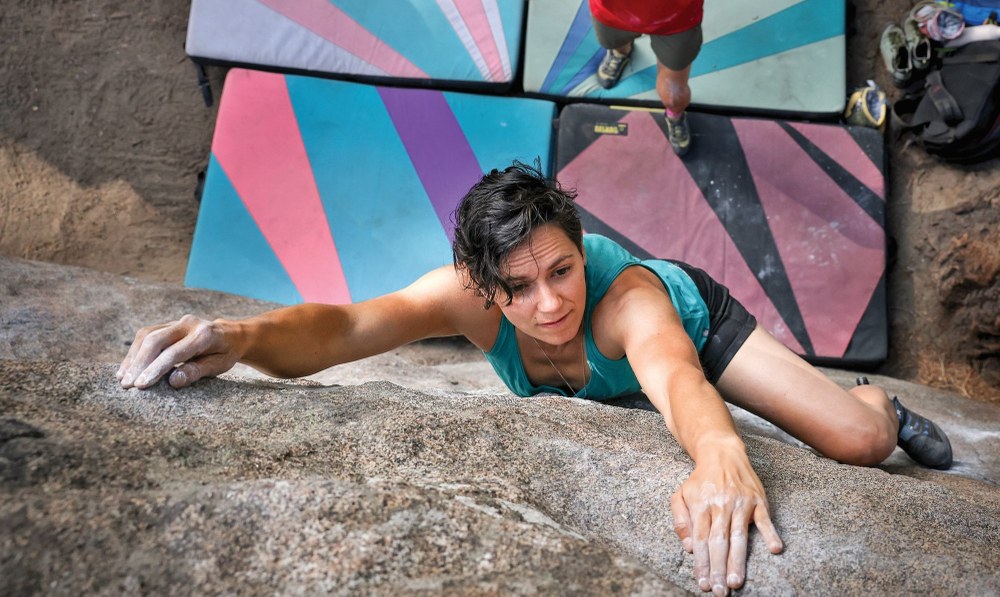
As a climber, I am no stranger to fear. I used to highball boulder – meaning I would climb tall boulders where the risk of falling meant serious injury – and without fail, I’d feel fear every time, whether or not I made it all the way up. One day, I was outdoor bouldering with friends fairly new to the sport. Halfway up the boulder, I reached a tricky section. Assessing the situation against my current skill levels, I realized if I went for the next move and missed, I wouldn’t just endanger myself, but my spotters, too. The move wasn’t worth the risk. I decided to descend.
Being honest about my fears was an even greater feat than finishing the boulder.
Fear isn’t talked about enough, especially in climbing. We usually consider fear a weakness – something to push past that makes us lesser than others. But in truth, the presence of fear is good. Fear lets us know when something isn’t right or our body isn’t prepared for what is being asked. We need fear to survive.
So, what do we do with our fear? Avoid it? Let it hold us back? First, we need to practice feeling fear, so we can understand where it’s coming from and make decisions rooted in confidence.
Confidence as the antidote to fear
In the dictionary, confidence is an antonym of fear. I believe confidence is the antidote to fear. To build confidence, we must acknowledge our fears and what they tell us about our skillset. When we understand our fears, we have the tools to make informed decisions. Sometimes that decision is to stop and bail. The point is, listen to yourself.
To address fear, we first need to expose ourselves to it. Exposure is essential to understanding how to improve, but it doesn’t mean you have to overextend your comfort zone. Instead of forcing yourself to ignore your fears, here are a few tools for accepting climbing-related fears and training appropriately.
Fall practice
If you’re attempting a challenging climb, do some practice falls before sending. Talk to your partner about how you will take your falls. Talk about catches, too. Make sure you’re comfortable with the height of the fall, and check in with your partner about how each catch went. Soon, you’ll both feel good about falls and catches, and you’ll be more aware of your limits.
Mock leading
Here’s a secret about highball bouldering: we do it on top rope first. The best way to figure out if a highball is safe is to dial in the moves while roped, then do it without a rope. But many rope climbers don’t give themselves the grace to ease into leading. Instead, they take uncontrolled falls to “overcome” their fears.
Rather than throwing yourself into leading, practice the skill in a controlled environment. Attach a short rope to your belay loop and practice clipping in, alternating which hand you clip with, using different clipping techniques, and exhaling breaths while clipping. Practice clipping stances as well that allow you to feel balanced and rested (such as heel hooks, drop knees, or hips in). Do all this while on top rope, and leave some slack on your rope so you feel what it's like to clip with no assist.
Bolt by bolt
Lead climbing bolt by bolt is a wonderful way to climb harder grades and projects. Take at each bolt (meaning let your climbing partner pull in the slack), then rest at each bolt as you scan the next sequence. It’s okay to rest and it’s okay to take, just communicate with your belay partner so there’s no pressure to hurry. Once you figure out the climb, you can connect bolts together. Before you know it, you’re building capacity and confidence in your movements.
Things to keep in mind
Managing fear and building confidence is like strength training: you start with a light weight, then slowly increase the weight as your training progresses. Do the same with climbing. Over time, small steps lead to great strides.
Remember, fear and grades do not correlate. Fear can have a louder voice on some days, and it can show up where it wasn’t present before. There are many external factors - weather, group dynamics, nutrition, fatigue, and more - that make each day and each attempt different. The body shows up differently each day, too, based on stress and recovery levels. We can’t expect to perform at the same level every day.
When you experience fear, acknowledge it. Your fear could help you grow, and it could save your life.
Mercedes Pollmeier is an NSCA-certified strength and conditioning specialist based in Seattle, with degrees in exercise science and human movement, and is a Precision Nutrition L2 Master Coach. Currently, she owns her own climbing coaching company, Modus Athletica, training climbers in person and online. Visit her online at modusathletica.com and on Instagram @modusathletica.
This article originally appeared in our fall 2024 issue of Mountaineer magazine. To view the original article in magazine form and read more stories from our publication, visit our magazine archive.
 Mercedes Pollmeier
Mercedes Pollmeier